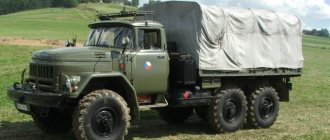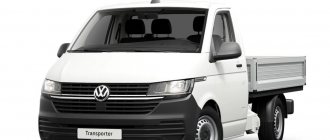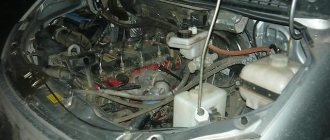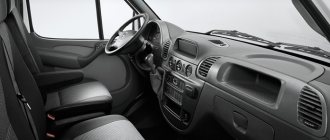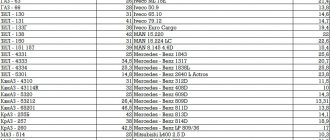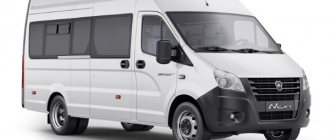Light-duty Gazelle trucks and vans have been produced by the GAZ plant since the end of 1995 and are widely used both for the delivery of various cargoes and as special-purpose vehicles. Fuel consumption on a Gazelle is one of the main parameters that determine the profitability of cargo transportation.
... about the model parameters
Cars use forced spark ignition engines running on liquid and gaseous fuel, as well as diesel engines with a controlled pressurization system.
Driving a Gazelle on a flat road
Basic fuel consumption rate for gas a22r32
Introduce changes to the Methodological Recommendations “Standards for the consumption of fuels and lubricants in road transport”, put into effect by order of the Ministry of Transport of the Russian Federation dated March 14, 2008 N AM-23-r, in accordance with the appendix to this order.
Appendix to the order of the Ministry of Transport of Russia dated _________ N ___
CHANGES MADE TO THE METHODOLOGICAL RECOMMENDATIONS “NORMS FOR CONSUMPTION OF FUELS AND LUBRICANTS IN ROAD TRANSPORT”, ENTERED INTO EFFECT BY ORDER OF THE MINISTRY OF TRANSPORT OF THE RUSSIAN FEDERATION OF MARCH 14, 2008 N AM-23 -P
1. In clause 7, the table of subclause 7.1.1 is supplemented with positions 103 – 111 in the following wording:
GAZ-A22R32 - Gazelle-Next with a Cummins IsF 2.8l diesel engine. Seven-seater cabin, cargo base 3 meters.
Fuel consumption on different Gazelle models
Fuel costs recorded by car owners depend on many factors.
... about the model parameters
The GAZ plant has been producing Gazelle models under one digital index for 10-20 years, constantly improving the design.
For example, in the Gazelle and Sobol product lines, modifications appeared with an all-wheel drive system and an additional transfer gearbox with a reduction stage, which increases cross-country ability on soft ground or snow-covered fields.
The production program of GAZ light-duty vehicles includes:
- base chassis for installation of add-ons by third-party companies;
- flatbed trucks with standard and extended wheelbase;
- minibuses and cargo-passenger modifications;
- versions with an all-metal van body.
Fuel consumption GAZ-2217
The GAZ-2217 Sobol minibus is made on a shortened Gazelle chassis and is equipped with single tires on the rear axle beam and a linkage front suspension.
Version with a carburetor engine with a capacity of 98 hp. With. consumes up to 11 liters of gasoline on the highway , and in the combined cycle the parameter reaches 13 liters (the plant stated in the specifications the values 9.5 and 10.7 liters, respectively).
The upgraded model with a 120-horsepower 2.8-liter Cummins ISF diesel engine and an all-wheel drive system burns up to 12 liters of diesel fuel on the highway at 80 km/h (the technical data sheet indicates consumption at 10.8 liters per 100 km).
Fuel consumption of GAZ-2217 when driving on the highway
Fuel consumption Gazelle Next
With the start of production of the Next model, cars began to use improved engines that meet Euro 4 or 5 standards. The base unit is the UMZ Evotech gasoline unit, diesel is installed upon request. The plant offers vehicles with standard and extended wheelbases (there is a special extra-long chassis available only with the Cummins ISF diesel engine).
Vehicles in the Next line are equipped with rear-wheel drive; all-wheel drive versions are not available.
Gazelle Next refrigerator
... about the fuel consumption of Gazelle Next
Fuel consumption Gazelle Next (a standard van or flatbed truck) with a gasoline engine burns 9.8 liters of fuel under steady state driving conditions; the diesel modification under similar conditions consumes 8.5 liters of diesel fuel.
Vans are characterized by increased consumption; during the running-in period, diesel consumes up to 18 liters of fuel; after grinding in parts and carrying out routine maintenance, the parameter drops to 11-13 liters. The difference between empty and loaded cars is 1.4-1.8 liters.
Fuel consumption standards for GAZ-2705
GAZ-2705 vans began to be assembled at the end of 1995; early series were equipped with a carburetor 8-valve engine with a capacity of 100 hp. s., which burned an average of 16 liters of fuel. Later, ZMZ-405, UMZ-4216 and Chrysler engines began to be used, characterized by improved technical characteristics and reduced fuel consumption. When driving on the highway, cars required up to 12 liters of gasoline; in the city, the parameter did not exceed 15 liters (with a full load).
fuel consumption of GAZ-2705 on a country road
... about the parameters of the GAZ-2705 model
The base engine is the UMZ Evotech engine with a control gasoline consumption of 9.8 - 12.1 liters, the gas fuel version burns 13 - 15 m³ of fuel per 100 km.
The diesel version with a Cummins ISF power unit and rear-wheel drive has a consumption of 8-10 liters (when driving on the highway at a speed of 60 to 80 km/h).
Fuel consumption Gazelle Farmer
Gazelle Farmer (Gaz-33023) is a combined cargo-passenger version of the model, allowing you to transport up to 5 passengers and up to 1 ton of cargo in a body with a volume of 4.5 cubic meters.
An extended version of the Gazelle Farmer is also produced - GAZ-330232 with an extended body up to 3.2 and 4.2 m
Cars of the Farmer series are distinguished by the installation of a transfer gearbox that distributes the flow of torque between the drive axles.
... about the fuel consumption of the model
Additional transmission units installed to increase cross-country ability increase the load on the engine, reducing its efficiency.
Tires with a rough tread pattern and increased ground clearance increase driving resistance and thus increase the fuel consumption of the Gazelle by 15-20% compared to the standard modification of the vehicle with rear-wheel drive.
Fuel consumption GAZ-3302
The GAZ-3302 flatbed truck became the founder of the Gazelle family; the plant shipped the first commercial samples to customers in the fall of 1994.
... about the fuel consumption of the model
Early copies of the Gazelle were equipped with a ZMZ-402 carburetor engine from a Volga passenger car; gasoline consumption in the city reached up to 20 liters, so owners en masse switched cars to compressed gas.
Later, the production program included a carburetor version of the 16-valve ZMZ-405 unit, which consumes up to 15 liters of fuel in city traffic, and on the highway at 80 km/h the car consumes 11-13 liters per 100 km.
model GAZ-3302
Over the subsequent years of production, the cars went through several cycles of modernization, affecting the external design and the list of power units.
By mid-2022, the plant is offering cars with Evotech generation engines (using gasoline or a compressed mixture of propane and butane) or with a Cummins unit. In addition to the standard 3-seater cab, a 6-seater 2-row modification is installed.
Gasoline consumption during control tests is 14 liters for gasoline versions with all-wheel drive; the diesel version requires up to 15 liters of diesel fuel per 100 km.
Fuel consumption of the GAZ-2752 truck
The GAZ-2752 minibus, belonging to the Sobol family, is equipped with an all-metal body with a passenger capsule that can accommodate 3 or 7 people. The plant uses a standard 4x2 transmission, but provides for the installation of all-wheel drive with a transfer gearbox, expanding the dynamic range.
The vehicles are equipped with an Evotech gasoline unit or a modification designed to use compressed natural gas (LPG); for an additional fee, a Cummins diesel unit with adjustable turbocharging is installed.
The reference fuel consumption declared by the manufacturer when driving on a highway at a speed of 80 km/h is:
- for the gasoline version - from 10 to 12 l;
- for a diesel model - from 7.8 to 9.8 l;
- for modification on gaseous fuel - from 13 to 15 m³.
Rear-wheel drive versions are more economical. Models of the 4x4 type burn up to 14-15 liters of diesel fuel in dense city traffic, and when operating on rough terrain, consumption reaches 17-18 liters.
... about the fuel consumption of GAZ-2752 on diesel
In severe off-road conditions, a diesel engine requires up to 20 liters of fuel (the fuel reserve is 70 liters, in such conditions the tank is enough for 350-400 km of travel).
Average fuel consumption of Gazelle GAZ-27527
The GAZ-27527 Sobol modification is equipped with an all-metal body and a 2-row cabin designed for 7 passengers. The minibus has rear-wheel drive as standard; a 4x4 version is offered.
The standard petrol variant is equipped with an Evotech unit, which requires 7.8 liters of fuel at a steady speed of 60 km/h; in urban conditions the car burns up to 11 liters of fuel. When using all-wheel drive, a 120-horsepower Cummins diesel engine is installed, consuming 10.7 and 13.2 liters per 100 km on the highway at speeds of 60 and 80 km/h, respectively.
Version GAZ-27527
Fuel consumption Gazelle Business
In 2010, the plant produced the first batch of the modernized Gazelle - Gazelle Business. Some of the achievements were the service interval increased to 15 thousand kilometers and fuel consumption reduced by 5%. Models based on Gazelle Business are marked with the code “288” in the model number. For example, the 6-metre Gazelle Farmer in the Business series is GAZ-33023-288.
The declared fuel consumption of Gazelle Business cars in liters per 100 km are shown in the table (data for 2020 model cars)
| Engine | Vehicle type | Combined cycle at 60 km/h | Mixed cycle at 80 km/h |
| Cummins | Onboard | 8,5 | 10,3 |
| Evotech | 9,8 | 12,1 | |
| Cummins | Van | 8,5 | 10,3 |
| Evotech | 9,8 | 12,1 | |
| UMZ gasoline | 10,5 | 13,0 | |
| UMZ propane | 13 m³ | 15 m³ | |
| Cummins | Bus | 8,5 | 10,3 |
| UMZ gasoline | 10,5 | 13,0 | |
| UMZ propane | 13 m³ | 15 m³ |
... about fuel consumption Gazelle Business
Used cars consume from 11 to 15 liters of fuel on the highway (depending on the type of engine and driving mode).
According to owners' reviews, in the urban cycle, diesel engines consume up to 14 liters of diesel fuel, while gasoline versions require up to 17 liters of gasoline (taking into account traffic jams or short-distance trips with partial warm-up of the power plant).
The plant offers buyers cars of the Sobol Business series (only with an Evotech engine), the reference fuel consumption is 9-10 liters, in urban use the parameter ranges from 10 to 14 liters per 100 km.
UAZ Patriot - analogue of GAZ
The Ulyanovsk Automobile Plant offers a Pro model with a carrying capacity of 1500 kg, which is positioned as a competitor to standard onboard Gazelles. The vehicles are equipped with gasoline engines; upon separate order, a propane-butane mixture injection system is installed (a cylindrical cylinder with a capacity of 100 liters hangs on the frame side member). The combined cycle gasoline consumption declared by the plant is 11.6 liters per 100 km, but owners note an increase in the parameter to 18-22 liters when driving on paved roads in winter with a payload weighing up to 1200 kg.
Europlatforms[ | ] All metal van
On buses with a petrol engine this function is carried out through the engine control unit, and on buses with a diesel engine through a blocking relay. The exterior of the new GAZelle’s cabin is attractive and moderately original, because the designers chose very interesting LED optics to decorate the front end.
| Steering | |
| Steering column | Tilt adjustable |
| power steering | Rack type |
| Suspension and brakes | |
| Front suspension | Independent |
| Rear suspension | Springs |
| Front brakes | Disk |
| Rear brakes | Drums |
Interior • All metal van
| Bus GAZ A65R52 -80 19 seats: sale, price, Samara, Kazan, Orenburg, service, technical characteristics, fuel consumption The sides remained the same, with the exception of the exterior mirror housings, which, as suggested by the GAZelle Next 2021 concept, will now be painted in body color. In the city I drive about 70-80 km/h, since the lowest number of revolutions at high speed depends on this, and in traffic jams it tends to be higher. |
| Gazelle Next 2.7, 2.8 fuel consumption rate per 100 km. diesel, gasoline, gas: reviews The flatbed light-duty truck Gazelle 3302 is the first commercial vehicle that began to be mass-produced at the Gorky Automobile Plant. The numbers indicated in the car’s technical passport are measured on a new car when driving on a flat horizontal surface with nominal tire pressure, no wind, etc. |
- Steel sides
- Gray or blue awning
- Power steering
- Heated mirrors
- Rear suspension stabilizer
- Radiator insulation
- central locking
- Door open alarm
- Power windows
- Steering wheel with height adjustment
- Cruise control
- Audio preparation
- Adjustable dashboard lighting
- Driver's seat with separate height, horizontal and back angle adjustments
- Webasto preheater
- Spare tools and accessories
Equipment • Previously, since March 2014, the production of frame-panel city small buses of the Citiline A63R4X and A64R4X series with a reinforced chassis was launched.
Factory fuel consumption standards for Gazelle
The plant indicates consumption standards obtained during test runs on a test track and at standard load. Cars are pre-serviced and adjusted to reduce driving resistance.
It should be borne in mind that it is possible to meet the factory standards only with a working car if you follow the rules of economical driving (for example, avoiding sharp accelerations or using inertial coasting with the gear engaged).
Gasoline models
When using spark-ignition engines, the standard fuel consumption of the Gazelle depends on the engine model and year of manufacture of the car.
at least 11 liters of fuel on the highway at a speed of 80 km/h ; reducing the speed to 60 km/h saves 1.5-2 liters of fuel. Buses and all-metal vans, due to their increased weight, consume 13-14 liters on the highway , and modifications with all-wheel drive burn up to 16.5 liters on the highway .
... about fuel consumption
In urban conditions, vehicles require from 14 (flatbed versions with 4x2 drive) to 20 liters of gasoline (buses on a 4x4 chassis).
Diesel models
Installing a compression ignition engine on a car allows you to reduce the fuel consumption of the Gazelle both when driving on the highway and in urban conditions (efficiency depends on the type of superstructure and model of the power unit).
For example, early modifications with a GAZ-5602 engine burned no more than 7.2 liters of diesel fuel per 100 km on the highway at a speed of 60 km/h (measured with a full load).
Models with a Cummins engine and all-wheel drive system consume an average of 12 liters of fuel; in the city, due to traffic jams or turning on the air conditioner, fuel consumption reaches up to 15 liters.
Gazelle diesel fuel consumption
Gas consumption on Gazelle models
Gas-cylinder equipment is installed in the factory or in specialized centers with a permit issued and information entered into the documents. On carburetor models, a reducer is used to reduce pressure; models with an injector are equipped with nozzles for gas injection. Converted engines can be operated on gasoline (for example, for starting at low air temperatures).
... about gas flow parameters
The control gas fuel consumption is from 12 to 15 m³ per 100 km (when driving on the highway at a speed of 60-80 km/h, respectively).
Gazelle fuel consumption at idle speed
When a cold engine starts, the injection system or carburetor supplies an enriched working mixture to the cylinders.
The hourly fuel consumption of the Gazelle at idle speed after starting the engine is in the range from 1.1 to 1.5 l/hour.
As it warms up, the mixture becomes leaner automatically (if a carburetor is used, the driver opens the damper manually), which leads to a decrease in the parameter to 0.7-0.8 l/hour. Running the engine idling for a long time (for example, in traffic jams or while waiting for loading or unloading) negatively affects efficiency.
Gazelle fuel consumption at idle speed
Review of the new version of NN
The new GAZelle NN features an updated exterior and a radically redesigned interior. The driver is offered a seat with 11 types of adjustments, and a 9-inch multimedia system screen is installed on the front console of the car.
By the end of 2022, dealers will receive gasoline and bi-fuel modifications of NN GAZelles with Evotech 3.0 engines with a capacity of 122 hp. With. In addition, the appearance of another diesel engine is being considered in the future - the same 2.8-liter, but with 170 hp. With.
This power unit, which meets Euro-6 standards, is currently installed on Turkish-assembled GAZ trucks. Finally, the developers do not rule out the appearance of an automatic transmission, but have not given any specifics yet, promising to reveal more information in the fall.
Electric cars[ | ] – Onboard vehicle
Modern technical solutions, components from the world's leading manufacturers, special attention to every detail, strict quality control are the distinctive features of Next, thanks to which this car works flawlessly. The engine management system is equipped with an engine locking device, the main function of which is to prevent the vehicle from starting to move with the sliding door open.
| Modifications | Diesel 2.8 l (149 l.s.) Manual transmission 2WD Standard chassis, combo | Diesel 2.8 l (149 l, s) Manual transmission 2WD Extended chassis |
| Are common | ||
| Production year: | 2021 — | |
| Brand country | Russia | |
| Country of assembly | Russia | |
| Guarantee | 3 years or 200,000 km | |
| Number of places | 7 | |
| type of drive | Rear | |
| Dynamic characteristics: | ||
| Acceleration to 100 km/h | — | |
| Maximum speed | 130 km/h | |
| Ground clearance | 170 | |
| Fuel consumption (l): | ||
| City | — | |
| Route | — | |
| Average | — | |
| Motor | ||
| Motor type | Diesel | Diesel |
| Brand | ISF2.8s4R148 | ISF2.8s4R148 |
| Power | 149 | 149 |
| Torque Hm | 340 | 340 |
| Compression ratio | 16,5 | 16,5 |
| Fuel used | — | — |
| Boost type | Turbine | Turbine |
| Dimensions and weight | ||
| Length mm | 5607 | 6207 |
| Width mm | 2513 | 2513 |
| Height mm | 2753 | 2753 |
| Wheelbase mm | 3145 | 3145 |
| Tank volume, liters | 80 | 80 |
| Trunk volume, liters | — | — |
| Vehicle weight, kg | 2445 | 2445 |
Main factors affecting Gazelle fuel consumption
The efficiency of internal combustion engines depends on the following general factors:
- Due to external climatic conditions, when operating a car in winter, fuel costs increase due to the need to warm up the engine and cabin, as well as deterioration of the road surface.
- Loading the cargo compartment, as the weight of the transported cargo increases, the consumption of gasoline or diesel fuel increases.
- Operating mode, on a suburban highway with a steady rhythm of movement, engines require less fuel. The maximum consumption is observed in urban operating mode (for example, when traveling short distances in traffic jams).
- The technical condition of the car (for example, a clogged air filter leads to an increase in consumption by 0.5-1.0 liters).
- Design features of machines that are supplied with rear axle or all-wheel drive. The 4x4 transmission is characterized by the use of a transfer gearbox, which leads to an increase in load and fuel consumption. Vans with a high superstructure differ from their flatbed counterparts in increased fuel consumption due to additional aerodynamic drag.
Fuel type: diesel or gasoline
When choosing the type of engine, it is necessary to take into account that gasoline engines are easier to start at air temperatures below -30°C.
... about diesel fuel consumption
The advantage of a diesel engine is increased torque and reduced fuel consumption, but repairing an imported power unit will cover the benefits received.
Spark-ignition engines can be converted to gaseous fuel; with a diesel engine, such manipulation is impossible.
A potential buyer of a Gazelle truck independently analyzes the advantages and disadvantages of engines, choosing the optimal solution.
An example of a rough calculation of fuel costs for a standard onboard Gazelle Next per year with a mileage of 100 thousand km:
- the modification with a gasoline engine burns 12.1 liters per 100 km/h; with a mileage of 100 thousand km, the car will consume 12.1 thousand liters of fuel with an octane rating of A-92. Fuel costs (at the average price for mid-2022) will be 12100 * 42.3 = 511.83 thousand rubles.
- The diesel version requires an average of 10.3 liters of diesel fuel; with the same mileage, about 10.3 thousand liters of fuel will be consumed. Fuel costs will be 10,300 * 46.9 = 483.07 thousand rubles, savings - only 28.76 thousand rubles.
Gazelle engine size
On classic Gazelle cars you can find in-line 4-cylinder liquid-cooled power units:
- petrol ZMZ-402 with a carburetor , with a cylinder volume of 2445 cm³, the unit develops up to 100 liters. With.;
- ZMZ-405 with a 16-valve head and a distributed injection system (carburetor modifications are also available), cylinder volume reduced to 2.28 liters;
- UMZ-4216 with distributed fuel injection and a volume of 2.89 l;
- Chrysler 2.4L-DOHC , borrowed from the Volga Cyber passenger car, has a volume of 2.4 liters;
- autodiesel GAZ-5602 , equipped with a supercharger and 8-valve block head, volume is 2.13 liters.
Gazelle engine
With the start of production of the new generation of Gazelle Next, 2.8-liter Cummins ISF2 diesel engines with power from 120 to 150 hp began to be used on the assembly line. With. (depending on boost pressure). For supporters of spark ignition units, cars with engines from the UMZ Evotech series are offered. With a cylinder volume of 2.69 liters, the engine develops 107 hp. s., the propane version is lowered to 104 liters. With. power.
The cylinder volume of Gazelle engines does not directly affect fuel consumption. For example, the Evotech UMP, which has a larger volume, requires 30-35% less fuel than the ZMZ-402.
... about comparing engine efficiency
When assessing the efficiency of engines, it is necessary to take into account design features and the method of fuel supply.
A similar situation is observed when comparing the characteristics of diesel engines. For example, Cummins ISF2 burns 15-20% less diesel fuel than GAZ-5602, while the power of the imported unit is 10-40 hp. With. higher than that of the Russian analogue.
Driving style
The main reason for increased fuel consumption is the load and driving style. Drivers who prefer a dynamic style of movement with the crankshaft spinning to high speeds in each gear are forced to visit gas stations more often.
Driving on country roads at speeds over 110 km/h reduces engine efficiency and increases the load on the driver.
Breakdowns and malfunctions of the Gazelle
Malfunctions affecting fuel efficiency:
- contamination of fuel spray nozzles;
- failure of part of the fuel injection system sensors;
- failure of the compressor (the problem only applies to diesel engines);
- jamming of brake pads due to contamination of the guides;
- untimely replacement of the air filter, which in turn can lead to misfires, as well as a clogged fuel filter;
- dirty Hall sensor affecting the operation of fuel injectors;
- damage to wheel bearings;
- faulty spark plugs;
- disruption of the normal operation of the main pair in the rear axle gearbox;
- wear of clutch discs;
- destruction of the catalytic converter (used on some cars), preventing the free exit of exhaust gases;
- incorrect operation of the coolant temperature sensor, supplying incorrect information to the control unit, which accordingly generates incorrect fuel supply;
- applies to trucks with ZMZ-402 carburetor engines - carburetor contamination, incorrect ignition adjustment, incorrectly set ignition (early ignition or late ignition), malfunctions in the ignition coil;
- leakage of liquid or gaseous fuel through damaged tubes.
How does the consumer benefit?
First of all, Next Cityline has a larger passenger capacity. The number of seats has been increased to 18+1 (in one modification, where there is an additional seat), and those who have to stand during the trip have virtually nothing to complain about: there is enough space in the aisles, visibility is provided along the perimeter, the ceiling height is 190 cm. It is worth noting that going up and down the steps has also become more convenient. In general, this bus risks becoming the number one favorite in the future for suburban and city lines.
It looks like the eternal dilemma of the “window” on a shuttle bus will be resolved. Because the new GAZelle Next cityline, as well as the minibus, are equipped with a powerful air conditioning system. Optionally, you can choose air conditioning or microclimate, two additional heaters for different areas of the cabin.
GAZelle next cityline has zone lighting and an emergency air hatch with a panoramic roof. The driver is not forgotten either: his seat is well adjusted in height and length, and the anatomical headrest will serve well on long flights.
The lineup. All metal vans
| Gazelle Next 2022 (NN) PRICES AND RESTYLING EQUIPMENT! VW engine, photo The flatbed light-duty truck Gazelle 3302 is the first commercial vehicle that began to be mass-produced at the Gorky Automobile Plant. The production of Gazelle Next cars, equipped with a UMZ A2755 EvoTech gas-gasoline 4-cylinder engine of Euro-5 standard, began in 2014 simultaneously with the start of production of the gasoline version. |
| Bus for transporting children GAZelle Next A66R33 with A275, equipment 8s4129Р Type Diesel Supercharging type Turbocharging Cylinder arrangement In-line Displacement, l 2.8 Number of cylinders 4 Cylinder diameter and piston stroke, mm 94 and 100 Compression ratio 16.5 Max power, hp kW at rpm 120 88.3 at 3600 Max torque, Nm at rpm 270 at 1400 3000 Transmission Gearbox Mechanical Number of gears 5 Main gear 4.3 hypoid Drive type Rear Differential Bevel, gear. Diesel engines are presented on the Russian light-duty truck in two versions: the Chinese Cummins with a power of 120 horsepower, and the Russian YaMX with a power of 149 horsepower. |
- GAZ-A21R32-30 (Cummins diesel E-4)
- GAZ-A21R33-10 (UMZ Evotech E-4)
- GAZ-A21R35-10 (UMP Evotech E-5 gas equipment)
Maintenance and warranty • power, automatic transmission, front-wheel drive, consumption 8.6 5.1 consumption.
GAZ A21R33 Lot No. 2
Region: Moscow region
Category: Cargo and comm. transport.
Starting price: RUB 640,861.00
Step: 32,043.05
Deposit amount: Deposit amount is 20% of the price. The deposit is made to secure the fulfillment of the Applicant’s obligations to conclude a property purchase and sale agreement, its payment, and towards payments due from the Applicant under the sale and purchase agreement in the event that the Applicant is recognized as the winner of the auction. The deposit is paid during the entire period of submission of applications in cash to a special bank account of the debtor using the following details: Name of Recipient: LLC "SP STEEL ROPE" INN of the recipient: 7701995364 OGRN of the recipient: 1137746338894 KPP of the recipient: 770101001 Account of the recipient: 4070281053800 0149508 Name of the Recipient's Bank: PJSC SBERBANK BIC of the Recipient's Bank: 044525225 Cor. account of the Recipient's Bank: 30101810400000000225 KPP of the Recipient's Bank: 773601001 INN of the Recipient's Bank: 7707083893 OGRN of the Recipient's Bank: 1027700132195 When transferring the deposit, the applicant is obliged to indicate in the purpose of payment the bidding code, lot number, name or full name of the applicant. If the applicant does not indicate this information when transferring the deposit, the auction organizer may not receive information about the deposit of the deposit and may not allow the applicant to participate in the auction. The auction organizer is not responsible for preventing the applicant from participating in the auction if the latter fails to indicate the purpose of payment when transferring the deposit of the auction code, lot number, name or full name of the applicant. Proper fulfillment by the applicant of the obligation to make a deposit is the transfer of funds in the amount of 20% of the price of the property being sold to the above-mentioned special account of the debtor no later than the closing date for accepting applications for participation in the auction. Otherwise, the Applicant’s obligation to pay the Deposit is considered unfulfilled. The risks of untimely execution by banks of payment documents and crediting of funds are borne by the applicant. The draft deposit agreement is attached to this message. The payment of a deposit is considered acceptance of this deposit agreement. It is also possible to sign an agreement during a face-to-face meeting with the auction organizer on paper or electronically. More detailed conditions are specified in the draft deposit agreement attached to this message. The deposit amount is returned to the Applicant who is not the winning bidder, if the seller has the bank details necessary to return the funds. The deposit is returned to the Applicant on the basis of his written application for the return of the deposit indicating the bank details for the details specified by the Applicant within 5 banking days from the date of receipt of the above application. The written application must be sent to the seller by mail to the address specified in the deposit agreement. The Seller’s obligation to return the Deposit is considered fulfilled on the day SBERBANK PJSC receives the corresponding payment order to return the Deposit. The Deposit amount is not returned to the Applicant in the following cases: 1) the Applicant’s victory at the auction and his subsequent failure to conclude a purchase and sale agreement with the Seller within the period established by Federal Law No. 127-FZ of October 26, 2002 “On Insolvency (Bankruptcy)” ; 2) concluding a purchase and sale agreement, but failing to transfer funds to pay for the lot within the time limits established by the purchase and sale agreement. The Applicant is obliged to immediately inform the Seller of changes in his bank details. If the applicant wins the auction, the deposit is not returned to the applicant, but is counted towards the fulfillment of the obligation of the winning applicant to pay the final price of the lot sold at the auction. The seller is not responsible for preventing the applicant from entering the auction if the latter fails to indicate the purpose of payment when transferring the Deposit of the auction code, lot number, name or full name of the applicant. The Seller is not responsible for the return of the Deposit if the Applicant fails to indicate the details for returning the Deposit when submitting the application and fails to submit an application for the return of the deposit containing details for returning the Deposit. The Seller is not responsible for untimely return of the Deposit if the Applicant fails to provide the Seller with his current bank details, as well as if the Applicant did not fully provide information about himself on the electronic trading platform or provided false information. The Seller is not responsible for the untimely return of the Deposit in the event of untimely execution of payment documents by banks.
The procedure for familiarizing yourself with the property (enterprise) of the debtor: All available documents and information on the lot are posted at the link: https://cloud.mail.ru/public/mAur/FahJcGYon There are no other documents, they will not be sent upon request. Inspection of the property takes place from 11/14/2021 to 12/17/21 once a week at the location of the property (Moscow region, Istra, Sovetskaya St., 46) STRICTLY by prior appointment (at least 5 working days in advance). To make an appointment for an inspection, inform us of your intention in free form by e-mail and wait for a response. The response will be sent strictly to the return email address; NO RESPONSE WILL BE SENT TO ANY OTHER ADDRESS SPECIFIED IN THE REQUEST. If a response does not arrive for a long time, contact the bankruptcy trustee in another way to exclude that the request ended up in spam. Contact phone number. A different procedure for review by agreement may be considered, but is not guaranteed.
General information: Lot 2 Starting price RUB 640,861. Truck GAZ A21R33 Truck with flatbed platform Identification number (VIN) X96A21R33K2741006 2022 model year X 230 TU 750 Color White Engine power, kW/hp 78.5/ 106.8 Engine displacement: 2,690 Mileage: more 152 150 PTS 52 RA 396391 vehicle registration certificate 99 06 No. 325437
- Link to lot
“Basic version” package
The increased height of the cabin not only made it more comfortable, adding a feeling of spaciousness, but also made it possible to install a luggage rack behind the seats. 8s4129Р Type Diesel Type of charging Turbocharging Cylinder arrangement In-line Displacement, l 2.8 Number of cylinders 4 Cylinder diameter and piston stroke, mm 94 and 100 Compression ratio 16.5 Max power, hp kW at rpm 120 88.3 at 3600 Max torque, Nm at rpm 270 at 1400 3000 Transmission Gearbox Mechanical Number of gears 5 Main gear 4.3 hypoid Drive type Rear Differential Bevel, gear.
Fuel consumption GAZ-3302 © All-metal vans
5 l Gearbox Mechanical Number of axles 2 Wheel formula 4 2 Weight 3215 kg Number of gearbox stages 5 Toxicity standard Euro 5 Overall dimensions Length 6900 mm Width 2000 mm Height 2700 mm User characteristics Condition new Brand Gazelle Next Model A65R52. Minibuses with this engine were produced at the Gorky Automobile Plant until 2008, but it did not provide such high fuel efficiency of the vehicle as the new Cummins.
Motor transport - rules, norms, regulations
Gas gazelle cars.
Gas gazelle vehicles are represented by flatbed cargo vehicles with 3 and 6-seater cabs with an awning, all-metal vans, vans (the van is mounted on a frame), buses and special vehicles. Below are the technical characteristics of the GAZ-3302 and GAZ-33023 cars.
- Weight, technical and operational characteristics of onboard cargo vehicles GAZ-3302 and GAZ-33023.
Table 1.
| Indicators | GAZ-3302 (3 m. cab) | GAZ-33023 (6-m. cab) |
| Wheel formula | 4×2 | 4×2 |
| Number of seats in the cabin | 3 | 6 |
| Weight of the equipped vehicle, kg | 1850 | 2050 |
| Load capacity, total, kg, including: | 1650 | 1450 |
| — weight of the driver and passengers (based on 75 kg per person) | 225 | 450 |
| — mass of transported cargo | 1425 | 1000 |
| Total weight, kg, including attributable to: | 3500 | 3500 |
| - front axle | 1230 | 1230 |
| - rear axle | 2270 | 2270 |
| Total weight of the towed trailer, kg | — | — |
| Length, m | 5470 | 5470 |
| Width, m | 2095 | 2095 |
| Height, m | 2120/ 2570 | 2200/ 2570 |
| Base, mm | 2900 | 2900 |
| Internal body dimensions: | ||
| Length, m | 3056 | 2308 |
| Width, m | 1945 | 1945 |
| Side height | 380 | 380 |
| Loading height, mm | 1000 | 1000 |
| Turning radius, m along the track of the outer front wheel | 5,5 | 5,5 |
| Maximum speed, km/h | 115 | 115 |
| Number of axes | 2 | 2 |
| Number of wheels | 6+1 | 6+1 |
| Tires | 175R 16C | 175R 16C |
| Tire air pressure, kg/cm2: | ||
| - front wheels | 3,0 | 3,0 |
| - rear wheels | 3,0 | 3,0 |
| Filling volumes, l: | ||
| - fuel tank | 68 (metal) 60 (plastic) | 68 (metal) 60 (plastic) |
| — engine cooling system with heater | 9,7 | 9,7 |
| — engine lubrication system | 6,0 | 6,0 |
| - gearbox housing | 1,2 | 1,2 |
| - rear axle housing | 3,0 | 3,0 |
| — steering mechanism with hydraulic booster | 1,3 | 1,3 |
| — hydraulic brakes | 0,52 | 0,52 |
| — hydraulic clutch | 0,2 | 0,2 |
| Platform | Metal, folding side and rear sides. There are racks for the awning arches | Metal, folding side and rear sides. There are racks for the awning arches |
Basic norms (suburban area in summer) of fuel consumption for GAZ - 3302 vehicles with engines:
- ZMZ-405220 (4L-2,464-145-5M) – 15.3 l per 100 km;
- ZMZ-4063.10 (4L-2.3-110-5M) – 15.5 l per 100 km;
- ZMZ-4025.10 (4L-2,445-90-5M) – 16.5 l;
- ZMZ-4026.10 (4L-2,448-100-4M) – 16.5 l;
- UMZ-42150 (4L-2.89-89-5M) -16.6 l.
- ZMZ-4025.10 (4L-2,445-90-4M) – 16.9 l;
- ZMZ-4026.10 (4L-2,445-100-5M) - GAZ-33023-16 (6 seats) - 15.7 l.
- Latest models of Gazelle cargo trucks (Gazelle - Next):
2.1. Model - A21R22 side-tent, 3-seater cabin. Gross weight 3500 kg, curb weight 2010 kg.
The base is 3145 mm (for GAZ 3302 - 2900 mm).
Engine model Cummins ISF2.8s4129P, diesel, turbocharged, power 120 hp.
The basic fuel consumption rate (suburban area in summer) is 11.7 liters per 100 km.
The A21R32 car has an extended wheelbase - 3745 mm, the basic consumption rate is 11.9 l (diesel fuel).
2.2. Model A22R22 - side-tent, two-row, 7-seater cabin (extended version A22R32 - length 6.4 m).
- Freight transportation of various brands of cars, including Gazelle cars, throughout the Moscow region and other regions of Russia is carried out by the transport organization “Gruzodar”. Website of the company Freight transportation in Elektrostal
- For the transportation of goods, in addition to the above models, the following types of Gazelle vehicles are used:
— all-metal vans;
— isothermal vans;
— manufactured goods vans;
— “sandwich” vans (for transporting goods that require a certain temperature regime - perishable and frozen products);
— refrigerated vans (isothermal van in which refrigeration equipment is installed);
— grain vans;
— milk tankers;
- dump trucks.
5. Calculation of fuel consumption for onboard cargo vehicles in various versions is presented in this article.
Avtotrans - consultant.ru.
Contents • Onboard vehicle
| GAZelle Next Cityline. Fuel consumption. Volume of the tank. Dimensions. Load capacity. Ecological class It is precisely because of the poor quality of diesel fuel that the GAZ-560 engines did not take root on Gazelles; they often broke down, and the overhaul of such a power unit caused many problems for car owners; the spare parts are expensive, the engine is difficult to repair and set up fuel equipment. In addition, the increased level of cabin comfort allows you to use the car both on short trips and on long intercity flights. |
